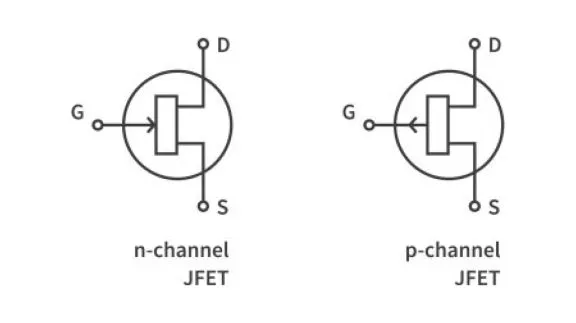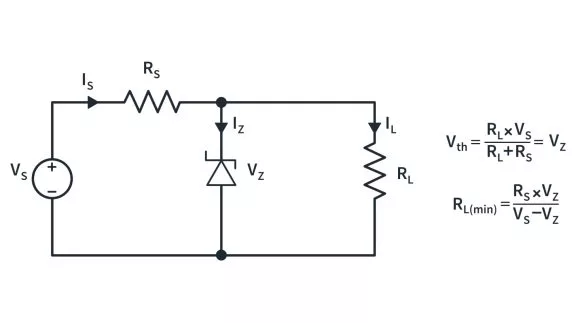Different Regions of BJT Operation
Published
In our previous tutorial about bipolar junction transistors (BJTs), we have discussed its basic structure and how its two types, npn and pnp, basically operate. This time, we are going to discuss the different operating regions of a BJT so that we can learn to use them properly in different applications.
But before we discuss the different operating regions of a BJT, we’re going to introduce first some basic parameters of a BJT and analyze a basic BJT circuit to derive some equations that will help us understand the operating regions.
BJT Parameters
So the first parameter is the DC beta (βDC) which is equivalent to the hybrid parameter (hFE) that you can find on the datasheet of transistors. DC beta (βDC) is the ratio of the DC collector current and the DC base current which means that it is the DC current gain of a transistor. Therefore, the value of the DC beta (βDC) determines the DC collector current.

Rearranging the equation,

However, if you check a BJT datasheet, you will find out that the DC beta (βDC) parameter is not constant. It changes with the collector current and the junction temperature. As you can see in the figure below, assuming that the junction temperature is not changing, increasing the collector current causes the DC beta (βDC) to increase and reach a maximum point. However, if the collector current continues to increase beyond the maximum point, the DC beta (βDC) will start to decrease. On the other hand, if the collector current is constant, the DC beta (βDC) varies directly with the junction temperature.

The second parameter of BJT is the DC Alpha (αDC). It is the ratio of the DC collector current and the DC emitter current. However, the DC Alpha (αDC) parameter is rarely used in transistor circuits, particularly compared to the DC beta (βDC) parameter. Its value is always less than 1 because the collector current is always less than the emitter current.

BJT Basic Circuit Analysis
Now let’s look at and analyze the basic BJT circuit in figure 2 as we are going to use a circuit similar to it later to understand the operating regions of a BJT. As we can see we have two external bias voltage sources, VBB and VCC, and two resistors, RB and RC. We can also see three important DC voltages across the transistor junctions, VBE, VCE, and VCB, and three DC currents, IB, IC, and IE.


The external bias voltage VBB forward-biases the base-emitter junction. The base-emitter junction as you can see in figure 3 is like a diode. So when it is forward-biased it will have a voltage drop across it similar to a diode, approximately 0.7V or higher. But to simplify things, we will just use 0.7V. So in the circuit, the voltage is designated as VBE.

By Kirchoff’s voltage law, the voltage across RB is:

And by Ohm’s law, the voltage across RB is also:

So,

Rearranging the equation, we can get the equation for the DC base current for this BJT circuit:

Using Kirchoff’s voltage law again, we can get the voltage at the collector with respect to the emitter which is equal to VCC minus the voltage drop across RC:



Now, to get the voltage across the collector-base junction, we need to subtract the voltage at the collector and the voltage across the base which in this circuit is VCE and VBE. So VCB is:

Take note that the collector here is n-type while the base is p-type. If the collector is at a higher voltage than the base, the collector-base junction will be reverse-biased. On the other hand, if the collector is at a lower voltage than the base, then the collector-base junction will be forward-biased.
BJT Regions of Operation
Now we’re done with the BJT parameters and basic BJT circuit analysis, let’s proceed to the operating regions of the BJT. As you can see in figure 4, there are three operating regions of a BJT, cutoff region, saturation region, and active region. The breakdown region is not included as it is not recommended for BJTs to operate in this region.

Cutoff Region
So let’s start with the cutoff region as it is the easiest one to understand. The nonconducting state of the BJT falls under the cutoff region. As shown again in figure 4, the BJT operates in the cutoff region when IB is equal to zero. In this case, there should be no current that will flow through the collector. However, in reality, there will be a very small collector leakage current that will flow due to the thermally produced carriers. But since this collector leakage current is very small, it can be neglected and VCE will be considered as approximately equal to VCC as shown in figure 5.

Saturation Region of BJT
The BJT operates in the saturation region when its collector current is not dependent on the base current and has reached a maximum. The condition for this to happen is that both the base-emitter and the base-collector junctions should be forward-biased. For example, in figure 6 we have a BJT circuit which is similar to the circuit that we’ve analyzed recently though their difference is that the external bias voltages here are variable.

Let’s say that the circuit is configured in this condition, VBB will forward-bias the base-emitter junction and produce a certain value of IB while VCC is zero. In this case, VBE will be approximately equal to 0.7V while the emitter and the collector are at 0V. As we’ve analyzed the basic BJT circuit recently, remember we’ve mentioned that if the collector is at a lower voltage than the base, then the collector-base junction will be forward-biased. Since the base voltage here, which is approximately 0.7V, is higher than the collector voltage which is 0V, then the base-collector junction is forward-biased.

Now, in figure 7 we set VCC to a non-zero value then increase the base current by increasing VBB. In this case, IC increases while VCE decreases since the voltage drop across RC also increases. As we further increase IB, IC also increases until VCE will reach the saturation voltage (VCE(sat)). This time, the BJT reaches saturation and IC can no longer increase regardless of the increase in IB.
Active Region

By using a load line, we can see that the cutoff point is at the bottom of the load line where IC is zero and VCE is equal to VCC while at the top of the load line is the saturation point where IC is equal to IC(sat) and VCE is equal to VCE(sat). Between cutoff and saturation along the load line is the active region of the BJT or also known as linear region. For the BJT to operate in the active region, the condition is that the base-emitter junction should be forward-biased while the base-collector junction is reverse-biased. In this region, IC almost remains constant for a given value of IB. But as VCE increases, IC increases slightly since the base-collector depletion region widens. When a BJT operates in the active region, ideally its output is a linear reproduction of the input signal.
Application/Summary
Knowing the different operating regions of a BJT will help you use it in different applications. For example, the concept of cutoff and saturation regions can be used to operate a BJT as a switch. When the BJT is operating in the cutoff region, then it could be used like an open switch while if it is operating in the saturation region, the BJT could be used as a closed switch. The BJT can be also used as an amplifier if you properly bias it to operate in the active or linear region. I hope you’ve found this tutorial interesting or helpful. If you have any questions, leave it in the comments below. See you in our next tutorial!

Get the latest tools and tutorials, fresh from the toaster.














